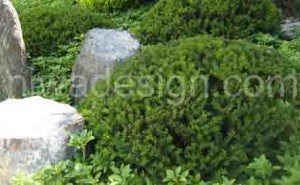Evergreens for Minnesota Gardens – Yews
 April 25, 2012
April 25, 2012
Yews are great plants for Minnesota gardens and enjoyed for their unique appearance. They have flat needles and are short. Their needles look dark green on their surface and light green on their underside. The new growth on the tips of the stems on the plants is bright chartreuse green that beautifully contrasts the dark green mature needles. If you look at their twigs, you will find it interesting to see that the needles are arranged on the twigs in a flat plane which are held opposite to each other along the stem. These are relatively slow growing and are very attractive especially when they are pruned nicely. They can grow in a variety of different soil conditions as long as they are well drained. Only thing the yews require are they should be kept moist. They are not resistant to drought conditions and require lots of water. Ironically, when Yews do have trouble growing it is most often due to soil conditions that are too wet. This leads to Phytophthora root rot; which is a fungal disease that develops due wet or poor drained soil.
Yews are available in many varieties inMinnesota. These specimens have a history of more than 3000 years. They are dioecious and are segregated as male and female plants. The bark, leaves and seeds of the female plants are poisonous to people and pets
Yews are very hardy and are healthy plants, but do occasionally have problems with scale i.e. sucking insects. When they are affected with scales, you can find small hard shells along the stems of the plants.
Yews are wonderful plants for Japanese gardens and one of my favorite for shearing into tamamono, or “dome” shapes. Â This is one of the most common forms found in Japanese gardens. Â If you prefer this look or other more formal sheared shapes, you can start trimming them in the early summer, cutting back the new growth that fades from bright green to dark green. Â They often bloom a second time in mid season. You can also prune them again in mid-August to keep them neat. Yews are very slow growing, so keep this in mind whenever you start pruning them.
If you are concerned that your soil does not drain well where you would like to plant Yews in your garden, you can test the drainage by digging a hole in the area one foot deep and wide and fill it with water. Â Once the water permeates into the soil fill it again, if the hole is still holding water after the second filling for a 4-5 hours the soil will be to wet for Yews.
Yews for Minnesota gardens:Â Â Â Â Â Â Â Â Â Â Â Â Â Â Â Â Â Â Â Â Â Â Â Â Â Â Â Â Â Â Â Â Â Â Â Â Â Â Â Â Â Â Â Â Â Â Â Â Â Â Â Â Â Â Â Â Â Â Â Â Â Â Â Â Â Â Â Â Â Â Â Â Â Â Â Â Â Â Â Â Â Â Â Â Â Â Â Â Â Â Â Â Â Â Â Â Â Â Â Â Â Â Â Â
Dwarf Bright Gold, Yew – This Yew is a spreading evergreen with an irregular habit.  The needles are green and gold with an overall golden-yellow look.  This Yew grows 8’ high and 6’-8’ wide with yellow foliage and has a broad upright shape.  This plant does best in partial shade, plant in part to full shade.
Emerald Spreader, Yew – This Yew has a nice consistent dark color green color throughout the winter and has red berries.  They grow 30†high and 3’-5’ wide with green foliage and a spreading shape.  This Yew can be planted in full sun to partial shade.
Japanese Upright – This is a slow growing upright Yew that needs protection from winter sun and well drained soil.  It typically grows 10’-12’ high and 3’-5’ wide, has dark green foliage and a pyramidal shape.
Nana Aurescens, Yew – This is a low spreading Yew with pretty yellow foliage and makes a nice specimen or accent plant.  It grows 18†high and 4’-6’ wide, has golden foliage and a spreading habit.  This Yew does best in partial shade.
Nova, Yew – Another slow growing Yew, this one has a columnar form and holds its dark green color year round.  It grows 4’-6’ high and 2’-3’ wide and has dark green foliage.  Plant this Yew in full sun to partial shade light conditions.
Taunton Yew – Taunton Yews are my favorite and are considered a low growing, dense evergreen with bright green needles. They grow 3’ high and 3’-4’ wide; have green foliage and a spreading habit.
If you would like our help with your landscape or Japanese garden project please contact us, Niwa Design Studio, at 952-470-1882.
You can also visit Japanese Garden Journal for more information about Japanese Gardens.

 Posted in
Posted in  content rss
content rss